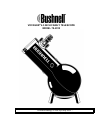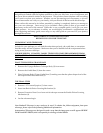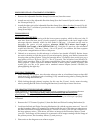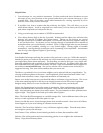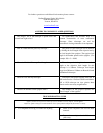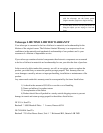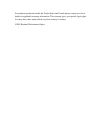
SHOULDER STRAP ATTACHMENT (IF DESIRED)
1. Remove the Adjustable Shoulder Strap (8) (not shown) from the carton.
2. Attach one end of the Adjustable Shoulder Strap (8) to the Forward Clips (6) on the side of
the Telescope Body (2).
3. Attach the other end of the Adjustable Shoulder Strap (8) to either the other Forward Clip (6)
or the Rear Clip (7), whichever provides the most comfortable position. Adjust the Shoulder
Strap (8) and enjoy.
TELESCOPE USE
SELECTING AN EYEPIECE:
1. You should always start viewing with the lowest power eyepiece, which in this case is the 31
mm lens. Note: the base power of each eyepiece is determined by the focal length of the
telescope objective element, which for this model is 500 mm. A formula can be used to
determine the power of each eyepiece: telescope OBJECTIVE mirror focal length
EYEPIECE focal length = MAGNIFICATION (e.g. Using the 31 mm lens, the calculation
would look like this: 500 mm ÷ 31mm = 16x or 16 power.) In addition, the 5mm eyepiece
will provide a magnification of 100x or 100 power.
2. Offered as an accessory for this telescope is a Barlow lens (model #78-0105). Barlow lenses
are used to double or triple the power of your telescope by placing your Barlow between the
focusing tube and the eyepiece. Using the example above, a 2x Barlow lens would give you a
total power of 32x or 32 power. (16 x 2 = 32x or 32 power). The 2x Barlow Lens (model #78-
0105) would provide a 200x or 200 power magnification when used in conjunction with the
5mm eyepiece. Other accessories available include a 9mm eyepiece (model #78-0101) that
would give you 56x or 56 power and a standard camera adapter (model #78-0104) for
photographing the night sky.
FOCUSING TELESCOPE:
1. After inserting the eyepiece, aim the main telescope tube at a land-based target at least 200
yards away (e.g. A telephone pole or building). Fully extend focusing tube by turning Rack &
Pinion Focusing Mechanism (4)
2. While looking through selected eyepiece (in this case the 31 mm), slowly retract focusing
tube by turning Rack & Pinion Focusing Mechanism (4) until object comes into focus.
COLLIMATING THE SECONDARY MIRROR
Good alignment or collimation of the telescope's optical components will guarantee the most
optimum viewing. This telescope body comes preassembled from the factory and
precollimated. Therefore collimation should not be required. However, due to its great
importance there are a few steps that you can take to ensure that your telescope is properly
collimated.
1. Remove the 1.25" Format Eyepiece (1) from the Rack and Pinion Focusing Mechanism (4).
2. Look into the Rack and Pinion Focusing Mechanism (4) with the eyepiece removed. You will
see the Secondary Mirror (5) located a few inches inside the end of the telescope tube nearest
the Rack and Pinion Focusing Mechanism (4). Since it is a mirror, you will see a reflection of
the large primary mirror. That mirror will show an image of the Secondary Mirror (5) and
your eye. Each image will be centered in a concentric set of images starting with the image of
the primary mirror, the Secondary Mirror (5), and your eye.
3. Please refer to the diagram to see what to expect.



